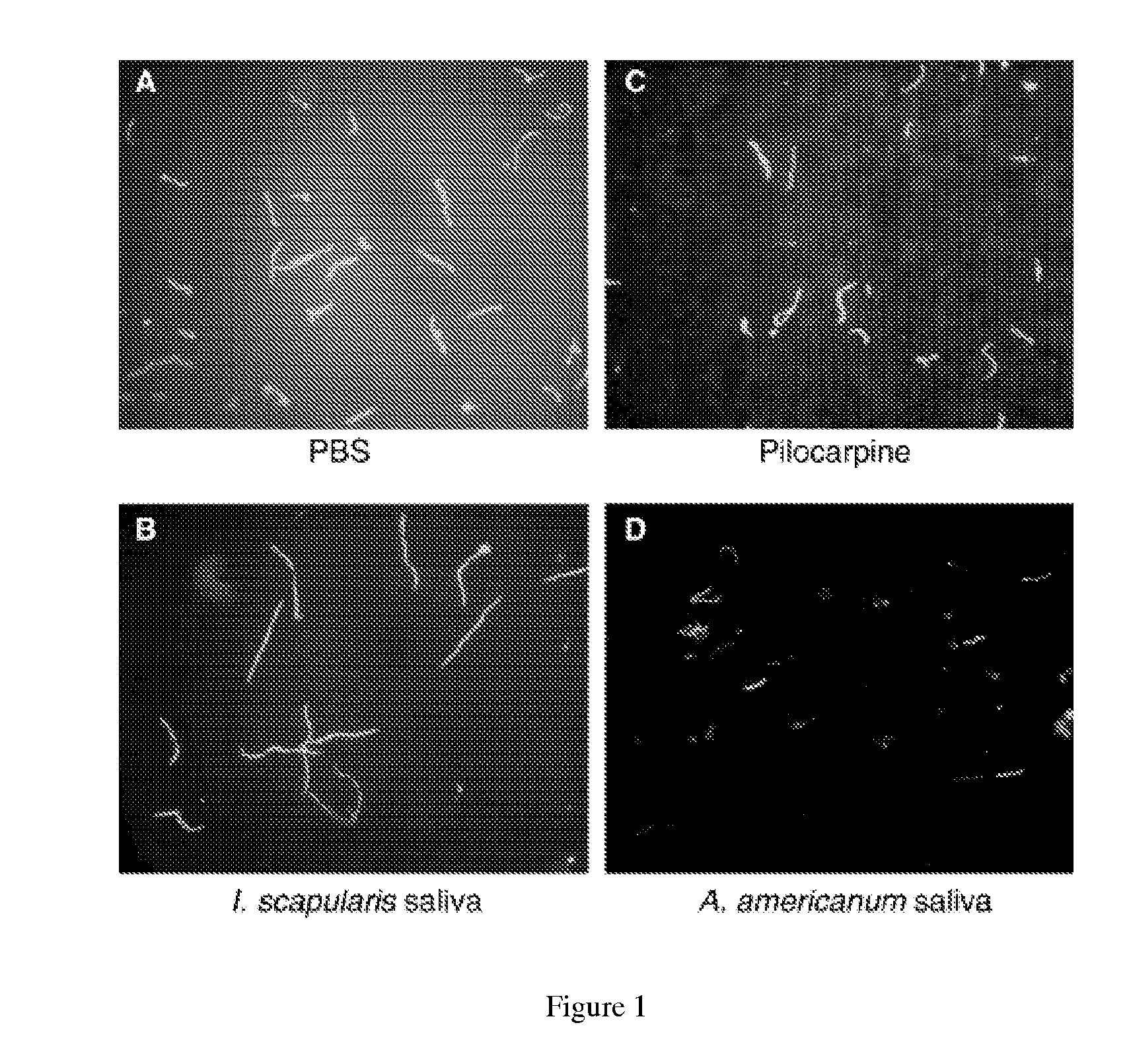Disease control with tick phospholipase A2
a tick phospholipase and tick technology, applied in the field of pharmaceutical and diagnostic compositions, can solve the problems of difficult design and implementation of therapeutic methods and reagents, burgdorferi /i> remains elusive, and the ability to discriminate between
- Summary
- Abstract
- Description
- Claims
- Application Information
AI Technical Summary
Benefits of technology
Problems solved by technology
Method used
Image
Examples
example 1
[0105]The cDNA of full-length A. americanum PLA2 is cloned from an A. americanum cDNA library and subcloned into the pET-21a(+) vector (Novagen, Madison, Wis.). The cDNA library is created from genomic DNA from A. americanum using the CloneMiner™ cDNA Library Construction Kit available from Invitrogen (Carlsbad, Calif.). Amplification and cloning of plasmids containing the cDNA for PLA2 is performed essentially as described by Wijewickrama, G T, et al., J. Biol. Chem., 2006; 281(43):32741, the contents of which are incorporated herein by reference. All constructs are transformed into DH5 cells for plasmid isolation, and their DNA sequences are verified. E. coli strain BL21 (DE3) was used as a host for the protein expression.
example 2
[0106]Isolation and purification of PLA2. PLA2 is purified from E. coli BL21 (DE3). The plasmid encoding PLA2 adds an amino-terminal His tag for subsequent purification. Optionally, the His tag is cleavable by incorporation of a cleavage sequence for enzymes such as trypsin, factor Xa, or thrombin. The bacteria are grown overnight at 37° C. in 2 liters of LB broth supplemented with 100 mg / liter of ampicillin; harvested by centrifugation; suspended in 30 ml of 10 mM Tris.HCl (THCl), pH 8.3; and sonicated for 15 min on ice. The cell debris is removed by centrifugation at 20,000×g for 15 min, and the supernatant is loaded onto a Ni-NTA agarose (Qiagen) column (1.5×3 cm). The column is washed with 50 ml of 1.0 M NaCl in THCl, and the protein eluted with a 40-ml linear gradient of 0-0.25 M imidazole in THCl. Recombinant protein is identified by SDS / PAGE, and peak fractions are pooled. The protein is dialyzed against 3 liters of THCl at 4° C. overnight and loaded on a DEAE Sepharose colum...
example 3
[0107]Evaluation of PLA2 protein regulation of B. burgdorferi viability. Analyses of PLA2 protein is performed essentially as described by Ledin, K. E., et al., Med. Vet. Entomol., 2005; 19(1):90-95, the contents of which are incorporated herein by reference. Frozen stocks of low-passage B31 B. burgdorferi isolates (Shelter Island, N.Y.) are reconstituted in BSK-H culture medium and maintained at 35° C. to log phase (Piesman, 1993). Spirochete cultures are diluted with BSK-H to a density of 4.7×107 viable spirochetes per mL as counted in a Petroff-Hauser chamber under dark-field microscopy, and distributed in 15 μL aliquots into 0.7 mL tubes for a total of 7.05×105 spirochetes per tube. A mean starting concentration of 155 live spirochetes per field is assessed prior to the addition of specific treatments. Each 15 μL aliquot of spirochetes in BSK-His treated with either 15 μL of sterile PBS, 15 μL of 1.33 mg / mL pilocarpine (based on the mid-range of pilocarpine found in previous ana...
PUM
| Property | Measurement | Unit |
|---|---|---|
| molecular weight | aaaaa | aaaaa |
| molecular weight | aaaaa | aaaaa |
| concentrations | aaaaa | aaaaa |
Abstract
Description
Claims
Application Information
 Login to View More
Login to View More - R&D
- Intellectual Property
- Life Sciences
- Materials
- Tech Scout
- Unparalleled Data Quality
- Higher Quality Content
- 60% Fewer Hallucinations
Browse by: Latest US Patents, China's latest patents, Technical Efficacy Thesaurus, Application Domain, Technology Topic, Popular Technical Reports.
© 2025 PatSnap. All rights reserved.Legal|Privacy policy|Modern Slavery Act Transparency Statement|Sitemap|About US| Contact US: help@patsnap.com



